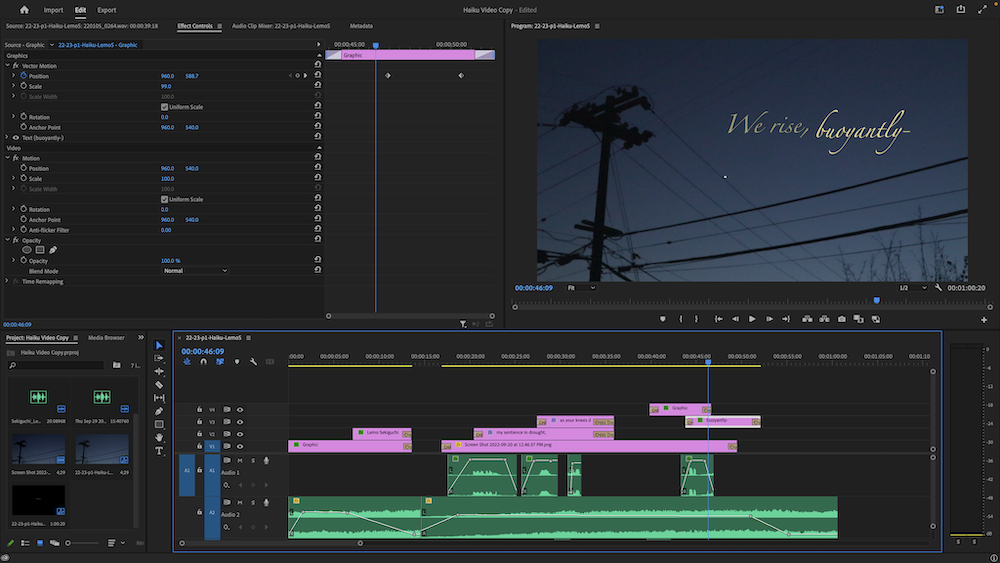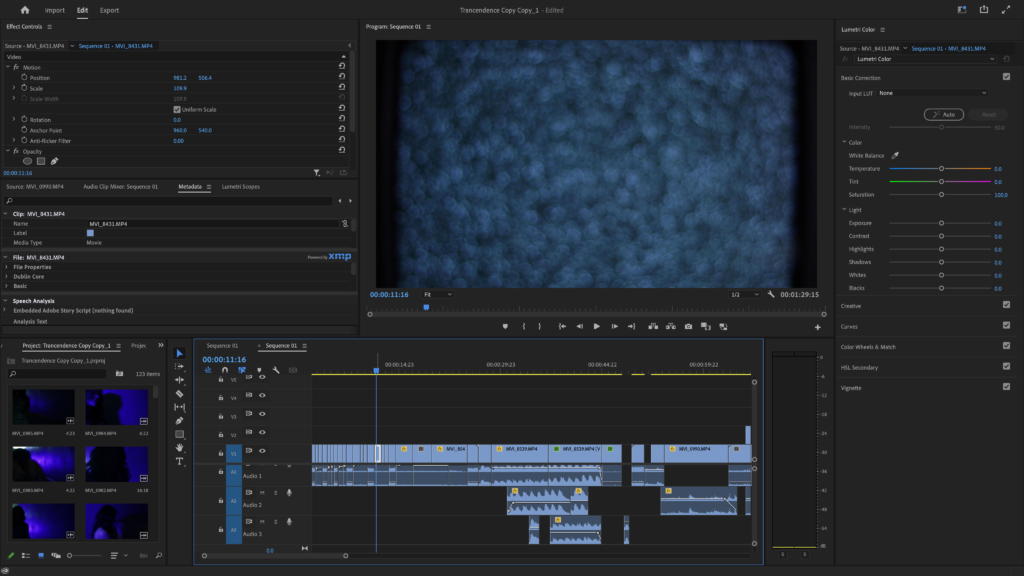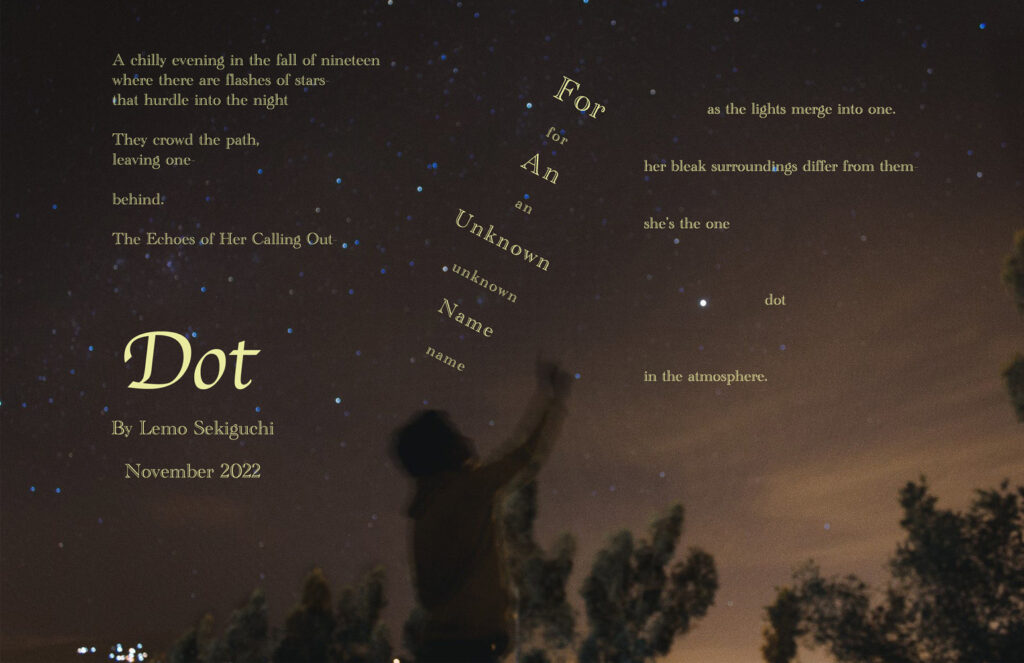Introduction
The Conceptual Unit emphasizes the creativity shown in abstract ways to express my thoughts and emotion through poetry, music, art, experimental film, and web production. The question we attempted to answer was “How can I use unconventional forms express myself?” I was challenged to take risks in my work to find a specific personal aesthetic. We learned technical communication skills using various modern equipment such as as DSLR Cameras, Tascam Audio Recorders, Adobe Photoshop, Adobe Animate, Adobe Premiere Pro, Adobe After Effects, Adobe Audition, Avid Pro Tools, WordPress, and Google Apps.
As a Freestyle student, I value the creative freedom we have over our projects and how we are able to connect the materials learned in English to Digital Media to make one meaningful project. I enjoy expanding my English projects further in a visual and auditory sense where we are able to see and hear, rather than through a reading in your head. When we hear the tone of the author’s voice when they illustrate a characters’s experience through an image, I believe it creates more meaning and depth where the audience can fully experience the poems or haikus.
Photo Haiku
In English, we wrote a 3 line, 5-7-5-syllable form of poetry called haiku about the experience and emotion that our concept statement had stated. We then added a photo that corresponded with our haiku to illustrate the mood. In Digital Media, we combined the photo and haiku together to create a photo haiku video, along with the recording of the haiku read in our voice, and background music to set the tone.

My concept statement was “I am exploring the feeling of amazement through transcendence.” When I thought of transcendence, it brought me back to a night in the fall when I had field hockey practice. I chose this picture because it resembled what that night looked like for me. During editing, I valued the emphasis we were able to put onto certain words from our haiku using key frames and vector motion. I was able to move certain words such as “We rise” to move upwards as it faded slowly.
Poetry
This assignment was a free verse poem, a poem that expresses strong emotions and ideas without relying on any certain structure where we let the poem form itself through the interaction of words, music, and literary techniques. After we finished writing the poem in English, we recorded an audio of us reading the poem in Digital Media. In addition to the recording, we used Photoshop to design our poem along with an image. We then used Pro Tools to edit the audio recording together with the design, and added sound-effects and music to set the tone.
Dot is a free verse poem about how we don’t always belong with the people who look like us. I imagine the speaker to be a star that appears in the evening who observes the millions of stars who act in accordance with each other. The stars she is observing all look exactly like her – a shiny, yellow, dot. Throughout this poem, I am exploring themes of vulnerability, betrayal, and isolation. In the first stanza, I bring the audience into the poem by describing the setting using visual and tactile sensory. Once the audience pictures an image of the setting, I use metaphor with ‘stars’ to represent specific groups in society who look like us, the audience. Who it represents changes accordingly to who is reading the poem. I also use assonance with the words, “chilly” and “evening” and “nineteen” as well as consonance with words, “flashes” and “stars”. With the introduction of the change in the line-break from the first stanza to the third line of the second stanza, the speaker’s attitude towards the millions of stars shifts from optimistic to melancholy. The speaker feels out of place acting in accordance with them, but believes that this is the only path for her since all of them look exactly like her. In this line break, she finally takes a risk and decides to end her cycle of acting in accordance with the stars. The space created after the second line of the second stanza makes “behind” stand out because in the mind of the reader, it evokes tension and betrayal that the speaker is facing. Before that line-break, the structure of the poem seems very crowded illustrating the other millions of stars who are in the cycle of acting in accordance. The end-break of using a period helps communicate to the readers how there is a long pause, and she is the only star who is left behind. Visually, it is showing how she is a step behind the stars who are all still in the cycle of acting in accordance with the other stars. In the third stanza, I personify the speaker of the star by giving them the ability to speak. I capitalized each first letter of the word in this line because of how it evokes the echoing and crisp sound it creates when saying the first syllable. I duplicated each word in the second line because I wanted to create a further echoing effect when the reader read the poem. Each of the first words before the duplicate starts off capitalized; the reader subconsciously reads the first words more loudly than the second words, creating this echoing sound. In the last stanza, I created space around “dot” to illustrate the speaker’s environment and how isolated she was. As we are in our youth, most of us feel obligated to find a specific group of people who we belong with, but I want the reader to consider that they are not compelled to find that group of people. Rather, they should work through finding themselves and where they really belong while wandering through life.
Through producing my poetry in various formats and mediums such as text, images, audio, and video, I value that we are able to learn variety ways of of how our poem could be illustrated using Photoshop and Protools.


Photoshop Blend Mode Editing
In Digital Media, we learned how to use the blend modes in Photoshop to improve the quality of our photos or creatively making our pictures more artistic.
I really enjoyed learning and using Photoshop Blend Modes because of how easily we can improve our photos. In addition, I value being able to make a new form of creative art using two photos that are not as creative. In the future, I see myself using my new Photoshop skills on my projects usefully to create artistic projects.
Film
During the Conceptual Unit in Film, we learned about Avant Garde and Experimental Filmmaking through watching various experimental filmmakers such as Maya Deren who created “Meshes of the Afternoon” in 1943. We explored how we are able to visually illustrate emotions through experiences using our conceptual statement.
I value being a Film student because it has allowed me to express my thoughts and view of life in a creative way. During the experimental unit, I really enjoyed exploring with the camera and the artistic choices you could make. In my film, I used a lot of shutter speed and lighting to set certain tones. In post-production, I experimented with different color grading to show the drastic transition between Act I and II. In Act I, I was able to engage in specific topics such as brain-washing and echo chamber in media which were topics that were always interesting to me. In Act II, I was able to illustrate the experience of transcendence and the feeling of knowing something the world doesn’t want you to know. Before Freestyle, the films I had made were always independent with no collaboration so I really loved the different ideas and perspectives I was receiving from my classmates during pre-production.

Below are some of my other work this semester:
The chase scene combines continuity editing, 180-degree rule, screen direction, suspense, Griffith’s pattern, and other techniques.
The Suspense Scene involved creating a scene that successfully creates tension. We used techniques such as Film language, crosscutting, “Show Don’t Tell”, privileged position, tempo in editing to create meaning, tension, and feeling.
The Doublemint exercise involved setting up the camera on a tripod in one position, then cropping and merging two separate clips into one.
In the Video Scavenger Hunt, we practiced different shots and angles on our DSLR cameras.










